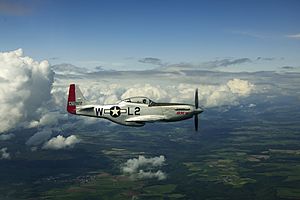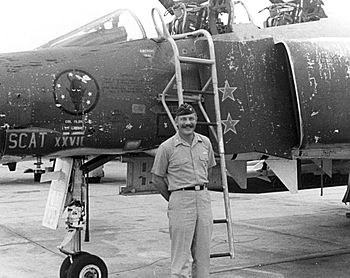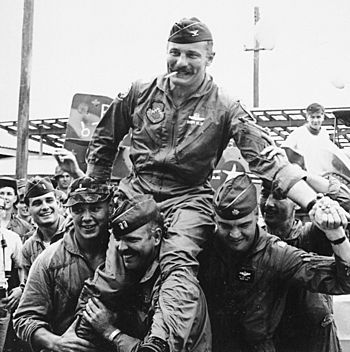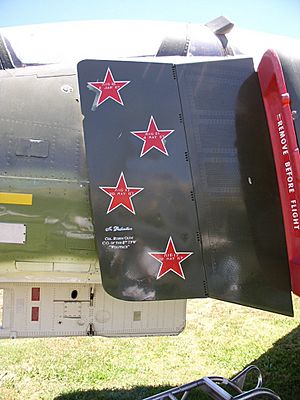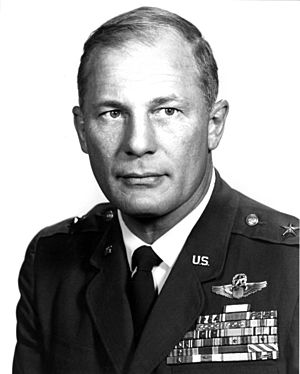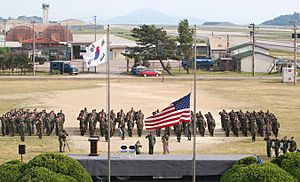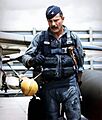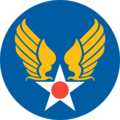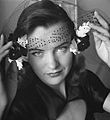Robin Olds facts for kids
Quick facts for kids
Robin Olds
|
|
|---|---|
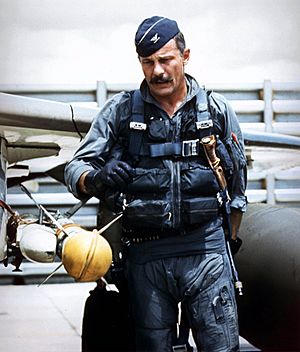
Olds with his trademark mustache, conducting a pre-combat mission walk around inspection of his F-4 fighter, at Ubon RTAFB, Thailand, circa Sept 1967.
|
|
| Birth name | Robert Oldys Jr. |
| Born | July 14, 1922 Honolulu, Hawaii, United States |
| Died | June 14, 2007 (aged 84) Steamboat Springs, Colorado, United States |
| Buried |
U.S. Air Force Academy Cemetery
|
| Allegiance | |
| Service/ |
|
| Years of service |
|
| Rank | |
| Unit | 479th Fighter Group 8th Tactical Fighter Wing |
| Commands held | 8th Tactical Fighter Wing 81st Tactical Fighter Wing 86th Fighter-Interceptor Group No. 1 Squadron RAF 434th Fighter Squadron |
| Battles/wars | World War II Vietnam War
|
| Awards | Air Force Cross Air Force Distinguished Service Medal (2) Silver Star (4) Legion of Merit Distinguished Flying Cross (6) Air Medal (40) Distinguished Flying Cross (United Kingdom) Croix de guerre (France) |
| Spouse(s) |
Abigail Morgan Sellers Barnett
(m. 1978; div. 1993) |
| Children | 3 |
| Relations | Robert Olds (father) |
Robin Olds (July 14, 1922 – June 14, 2007) was a famous American fighter pilot and general in the United States Air Force (USAF). He was known as a "triple ace" because he shot down 17 enemy planes in total during World War II and the Vietnam War. He retired in 1973 as a brigadier general, after serving for 30 years.
Robin Olds was the son of a U.S. Army Air Forces Major General, Robert Olds. He went to West Point and grew up around the early days of the U.S. Army Air Corps. Olds was a great example of a young World War II fighter pilot. He stayed in the Air Force even when he disagreed with its leaders. He was also one of the first jet pilots. Olds became the commander of two fighter wings. Many aviation experts and his fellow pilots consider him the best wing commander of the Vietnam War. This was because of his amazing air-fighting skills and his leadership in combat.
After returning from Vietnam, Olds was promoted to brigadier general. However, he did not lead another major command. He spent the rest of his career in non-flying jobs. These included being the Commandant of Cadets at the United States Air Force Academy. He also worked in the Air Force Inspector General's Office.
Olds had a very public life and career. He was even married to Hollywood actress Ella Raines. When he was younger, he was also a talented athlete. He was named an All-American in college football.
Contents
Early Life and Education
Robin Olds was born Robert Olds Jr. in Honolulu, Hawaii, on July 14, 1922. He came from a military family. He spent most of his childhood in Hampton, Virginia, where he went to school. His father, Robert Oldys (later Olds), was a pilot in France during World War I. He also worked for Brigadier General Billy Mitchell. Robin's mother died when he was four, so his father raised him.
Growing up, Olds often met officers who would later lead the U.S. Army Air Forces in World War II. This made him very dedicated to the air service. When he was three, his father even took him to court. Robin was dressed in an Air Service uniform for newspaper photos.
Olds first flew a plane when he was eight years old. It was an open-cockpit biplane with his father. By age 12, Olds decided he wanted to go to the U.S. Military Academy at West Point. His goals were to become an officer, a military aviator, and to play football.
His father became the commander of the 2nd Bombardment Group at Langley Field in 1937. Olds went to Hampton High School. He was class president for three years. He also played varsity football on a team that won the state championship in 1937. Olds was a tough player. He received offers for football scholarships from other colleges.
Instead, Olds went to a special school to prepare for West Point. When Nazi Germany invaded Poland in 1939, Olds tried to join the Royal Canadian Air Force. However, his father would not let him. Olds passed the West Point entrance exam and was accepted in 1940. After the Japanese attack on Pearl Harbor, Olds was sent for flight training. He finished this training by Christmas 1942. Olds then returned to West Point. He hoped to graduate early and join the war.
West Point Football Star
Olds played on the varsity college football team in 1941 and 1942. He was tall and strong, playing tackle on both offense and defense. In 1942, he was named "Lineman of the Year" and "Player of the Year" by sports magazines. Olds was also chosen as an All-American.
In the 1942 Army–Navy Game, Olds lost two front teeth during a tackle. But he returned to the game! In 1985, Olds was honored in the College Football Hall of Fame.
During his time at West Point, Olds learned to fly. He completed his flight training in 1943. Olds received his pilot's wings from General Henry H. Arnold on May 30, 1943. He graduated from West Point on June 1, 1943.
World War II Fighter Pilot Missions
After West Point, Second lieutenant Olds finished fighter pilot training. He learned to fly the Lockheed P-38 Lightning. This plane had two engines. He practiced gunnery and became very skilled.
Olds was promoted to first lieutenant in December 1943. In early 1944, he joined the new 434th Fighter Squadron. Olds flew 650 hours during training. He flew 250 hours in the P-38 Lightning. His group, the 479th Fighter Group, became very good at combat. They left for Europe in May 1944. They arrived in RAF Wattisham, England, on May 15.
P-38 Lightning Missions
The 479th began combat missions on May 26. They flew to protect bombers and attack targets in France before the invasion of Normandy. Olds flew a new P-38J Lightning he called Scat II. His crew chief, T/Sgt. Glen A. Wold, said Olds was very interested in how the plane worked. He even helped wax his aircraft to make it faster. On July 24, Olds was promoted to captain. He became a flight leader. On August 14, Olds shot down his first German planes, two Focke-Wulf Fw 190s.
On August 23, Olds was on a mission to Wismar. His flight saw 40–50 Messerschmitt Bf 109s. Olds chased them for ten minutes, climbing above them. He and his wingman attacked. Both engines of Olds' P-38 stopped because he ran out of fuel in those tanks! He kept attacking, hitting his target. After damaging the Bf 109, he dove and restarted his engines. Even with damage to his plane, Olds shot down two planes. He shot down another on the way home. This made him the first ace of his group.
Olds shot down eight planes while flying the P-38. Five of these are officially confirmed. He was known as the top-scoring P-38 pilot in Europe.
P-51 Mustang Pilot Missions
The 479th Fighter Group switched to the North American P-51 Mustang in September. Olds learned a lesson about being overconfident. During his second flight, the powerful single-engine plane made him spin off the runway while landing. Olds shot down an Fw 190 in his new Scat VI on October 6. This was during a tough battle near Berlin. He finished his first combat tour on November 9, 1944. He had flown 270 hours in combat and had six kills.
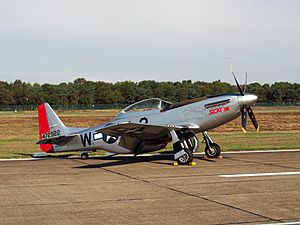
After a two-month leave in the United States, Olds started his second tour in England on January 15, 1945. He became the operations officer for the 434th Fighter Squadron. Olds was promoted to major on February 9, 1945. He claimed his seventh victory that same day, shooting down another Bf 109. On February 14, he claimed three more victories.
His last World War II air kill was on April 7, 1945. Olds led his group on a mission to protect bombers. Olds saw German Me 262 jets attacking the bombers. He chased one jet to draw it away. Then he returned to the bombers. Olds saw a Bf 109 attack and shoot down a B-24. Olds chased the Bf 109 through the formation and shot it down.
Olds destroyed many German planes on the ground in the following week. He destroyed six planes on April 13 and 16. Olds became a squadron commander on March 25. He was only 22 years old. By the end of the war, he was officially credited with shooting down 13 German planes in the air. He also destroyed 11.5 planes on the ground. Olds became an ace in both of his combat tours. He was the only pilot to become an ace in both the P-38 (5 victories) and the P-51 (8 victories).
Post-War Career and Jet Flying
After World War II, Olds returned to the United States. He became an assistant football coach at West Point. In February 1946, he moved to California to fly the Lockheed P-80 Shooting Star, one of the first jet fighters. This began his long career of flying jets.
In April 1946, Olds and Lieutenant Colonel John C. "Pappy" Herbst formed what they believed was the Air Force's first jet aerobatic team. They performed amazing stunts for crowds. In June, Olds was one of four pilots who made the first one-day, round-trip jet flight across the United States.
In 1948, Olds went to England as part of an exchange program. He flew the Gloster Meteor jet fighter. He commanded No. 1 Squadron of the Royal Air Force (RAF). He was the first foreigner to command an RAF unit during peacetime. After this, Olds returned to the U.S. to fly F-86A Sabres.
Olds was promoted to lieutenant colonel in 1951 and colonel in 1953. He was only 30 years old. He worked in several staff jobs until 1955. Then he returned to flying. He commanded the 86th Fighter-Interceptor Group in West Germany. From 1956 to 1958, he was in charge of all fighter weapons training for U.S. Air Forces in Europe.
From 1958 to 1962, Olds worked at the Pentagon. He wrote papers that turned out to be very accurate. He pointed out the need for better weapons and more training in regular warfare. These issues later became problems in the Vietnam War. In 1963, Olds graduated from the National War College.
Olds then became commander of the 81st Tactical Fighter Wing in England in 1963. This wing flew McDonnell F-101 Voodoo fighter-bombers. They had both nuclear and regular bombing roles for NATO. Olds brought Colonel Daniel "Chappie" James Jr. to work with him. James later became the first African-American 4-star Air Force general.
In September 1966, Olds was chosen to command an F-4C Phantom wing in Southeast Asia. He quickly learned to fly the Phantom. He even practiced firing missiles on the way to his new assignment.
Vietnam War Missions
On September 30, 1966, Olds took command of the 8th Tactical Fighter Wing at Ubon Royal Thai Air Force Base in Thailand. The wing needed more aggressive leadership. Olds immediately put himself on the flight schedule as a new pilot. He challenged his junior officers to train him well. He wanted to show them he would lead by example.
Olds' second-in-command was Colonel Vermont Garrison, an ace from World War II and Korea. In December, Daniel James Jr. joined them as deputy commander. This team became known as "Blackman and Robin." Olds flew his F-4C Phantom, which he named "Scat XXVII."
Operation Bolo and MiG Kills
Olds suggested a plan to trick the North Vietnamese Mikoyan-Gurevich MiG-21s into a trap. This plan became "Operation Bolo."
In late 1966, the F-105 Thunderchiefs used radar jamming pods to avoid missiles. This made the MiGs attack the F-4 Phantoms more often. Olds' plan was to make F-4s look like F-105s. They would use jamming pods, F-105 call signs, and fly like F-105 bombing missions. This would trick the MiG-21s into attacking what they thought were bombers, but would actually be F-4s ready for air-to-air combat.
The mission was set for January 1, 1967. Bad weather delayed it by a day. On January 2, the F-4s flew over North Vietnam. Olds led the first flight. MiGs started appearing through the clouds. The F-4s were ready. They shot down seven MiG-21s without losing any U.S. planes. Olds shot down one of the seven. This mission greatly reduced MiG activity for 10 weeks.
On May 4, Olds destroyed another MiG-21. Two weeks later, on May 20, he destroyed two MiG-17s. This brought his total confirmed kills to 16 (12 in World War II and four in Vietnam). This made him a triple ace. Olds later said he purposely avoided shooting down a fifth MiG in Vietnam. He learned that if he did, he would be sent home for publicity. He wanted to stay and fight.
He received the Air Force Cross for an attack on the Paul Doumer Bridge in Hanoi on August 11. He flew his last combat mission over North Vietnam on September 23, 1967.
Olds flew a total of 259 combat missions. This included 107 in World War II and 152 in Southeast Asia. His plane, Scat XXVII, is now on display at the National Museum of the United States Air Force in Ohio.
Olds' Famous Mustache
Olds was famous for his very long, waxed handlebar moustache in Vietnam. It was against military rules. Many airmen grew "bulletproof mustaches" for good luck. Olds also used his as a sign of defiance. He said, "It became the middle finger I couldn't raise in the PR photographs." When he returned home, his mustache had to go. The Air Force Chief of Staff, General John P. McConnell, told him to "Take it off."
This incident is said to have started a new Air Force tradition called "Mustache March." Airmen around the world grow mustaches for one month. It's a fun way to show solidarity and protest the facial hair rules.
Fighting for Dogfighting Skills
Olds often wished his F-4C had an internal gun. However, he did not let his fighters use gun pods. He knew his pilots were not trained in gun use or dogfighting. He also thought the pods would slow down the F-4s. They would also reduce the number of bombs the planes could carry. Delivering bombs was the main mission of his wing.
Olds' P-38 dogfights and Operation Bolo were shown in the "Air Ambush" episode of the History Channel's Dogfights series. Olds, at 84 years old, appeared as a commentator.
Later Career and Retirement
After leaving command of the 8th TFW in September 1967, Olds went to the United States Air Force Academy in Colorado Springs, Colorado. He became the commandant of cadets for three years. He worked to improve morale after a cheating scandal. Olds was promoted to brigadier general on June 1, 1968.
In February 1971, he started his last job. He was the director of aerospace safety. He helped create rules for Air Force accident prevention programs. He also dealt with workplace safety and accident investigations.
In late 1971, Olds toured U.S. Air Force bases in Thailand. He flew several unauthorized combat missions. He reported that Air Force pilots were not well-trained in air-to-air combat. He warned that losses would be high if fighting started again.
When the Operation Linebacker bombing campaign began in May 1972, U.S. fighter jets returned to North Vietnam. The Navy and Marine Corps fighters did well because of their TOPGUN program. But the Air Force struggled, just as Olds had predicted. Olds offered to take a lower rank to return to command and fix the situation. His offer was refused. He decided to leave the Air Force. He retired on June 1, 1973.
Awards and Honors
Robin Olds received many awards and decorations for his bravery and service.
 |
||
| U.S. Air Force Command Pilot Badge | ||
| Air Force Cross | Air Force Distinguished Service Medal with one bronze oak leaf cluster |
Silver Star with three oak leaf clusters |
| Legion of Merit | Distinguished Flying Cross with Valor device and silver oak leaf cluster |
Air Medal with four silver oak leaf clusters |
| Air Medal with three silver and one bronze oak leaf clusters (second ribbon required for accoutrement spacing) |
Air Medal with oak leaf cluster (third ribbon required for accoutrement spacing) |
Air Force Commendation Medal |
| Air Force Presidential Unit Citation with four oak leaf clusters |
Air Force Outstanding Unit Award with Valor device and three oak leaf clusters |
Air Force Outstanding Unit Award (second ribbon required for accoutrement spacing) |
| American Defense Service Medal | American Campaign Medal | European-African-Middle Eastern Campaign Medal with silver and bronze campaign stars |
| World War II Victory Medal | National Defense Service Medal with one bronze service star |
Vietnam Service Medal with two campaign stars |
| Air Force Longevity Service Award with one silver and one bronze oak leaf clusters |
Small Arms Expert Marksmanship Ribbon | Distinguished Flying Cross (United Kingdom) |
| Croix de Guerre with silver star (France) |
Vietnam Air Force Distinguished Service Order (2nd Class) |
Vietnam Air Gallantry Cross with gold wings |
| Vietnam Air Service Medal, Honor Class | Vietnam Gallantry Cross Unit Citation | Vietnam Campaign Medal |
Other Honors and Recognition
In 1968, Olds received the Golden Plate Award from the American Academy of Achievement.
In 2001, Olds was honored in the National Aviation Hall of Fame. He is the only person to be in both the National Aviation Hall of Fame and the College Football Hall of Fame.
Promotions and Ranks
| Rank | Date |
|---|---|
 Second Lieutenant Second Lieutenant |
1 June 1943 |
 First Lieutenant First Lieutenant |
1 December 1943 |
 Captain Captain |
24 July 1944 |
 Major Major |
9 February 1945 |
 Lieutenant Colonel Lieutenant Colonel |
20 February 1951 |
 Colonel Colonel |
15 April 1953 |
 Brigadier General Brigadier General |
1 June 1968 |
Personal Life and Family
In 1946, Robin Olds met Hollywood actress Ella Raines. They married in Beverly Hills on February 6, 1947. They had two daughters, Christina and Susan. They also had a son who was stillborn.
Their marriage lasted 29 years. It was often difficult because of their different lifestyles. Ella Raines did not want to live in military housing. Robin Olds and Ella Raines divorced in 1976. Robin later married Abigail Morgan Sellers Barnett in 1978. They divorced after 15 years.
In his retirement, Olds lived in Steamboat Springs, Colorado. He loved skiing and was active in his community. He also gave many public speeches.
Death and Legacy
In March 2007, Olds was hospitalized for complications from cancer. On June 14, 2007, he died from heart failure in Steamboat Springs, Colorado. He passed away one month before his 85th birthday.
He was honored with a flyover and services at the United States Air Force Academy. His ashes are kept there. Robin Olds is remembered as the Class Exemplar for the Academy Class of 2011.
Images for kids
See also
 In Spanish: Robin Olds para niños
In Spanish: Robin Olds para niños


